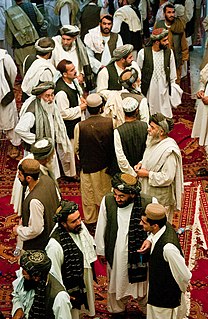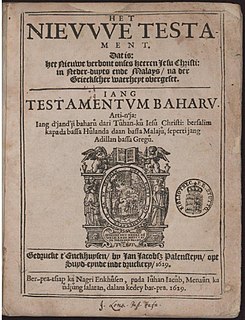Related Research Articles

Pashtuns, historically known as Afghans, are an Iranian ethnic group native to Central and South Asia. The ethnic group's native language is Pashto, an Eastern Iranian language. Additionally, ethnic Pashtuns in Afghanistan speak the Dari dialect of Persian as a second language, while those in the Indian subcontinent use Hindi-Urdu as a second language. However, a significant minority speaks Persian or Hindi-Urdu as their first language. The total number of Pashtuns is estimated to be around 63 million; however, this figure is disputed, because of the lack of an official census in Afghanistan since 1979.

Pashto, sometimes spelled Pukhto or Pakhto, is an Eastern Iranian language of the Indo-European family. It is known in Persian literature as Afghani.

The Yusufzai or Yousafzai, also referred to as the Esapzai or Yusufzai Afghans historically, are one of the largest tribes of ethnic Pashtuns. The tribe's origin is Kandahar, Afghanistan.

The Pashtun tribes, historically also known as Afghan tribes, are the tribes of the Pashtun people, a large Eastern Iranian ethnic group who use the Pashto language and follow Pashtunwali code of conduct. They are found primarily in Afghanistan and Pakistan and form the world's largest tribal society, comprising over 49 million people and between 350 and 400 tribes and clans. They are traditionally divided into four tribal confederacies: the Sarbani (سړبني), the Bettani (بېټني), the Gharghashti (غرغښتي) and the Karlani (کرلاڼي).
Ormuri also known as Baraki, Ormur, Ormui or Bargista is an Eastern Iranian language spoken in South-east Afghanistan and Waziristan. It is primarily spoken by the Burki people in the town of Kaniguram in South Waziristan and Logar, Afghanistan. The language belongs to the Eastern-Iranian language group. The extremely small number of speakers makes Ormuri an endangered language that is considered to be in a "threatened" state.

Bishop Jens Christensen was a Danish Lutheran missionary and bishop. Christensen was consecrated Bishop of the Lutheran Church in Pakistan (PLC) in 1955.

Translations of the Bible into Arabic are known from the early Christian churches in Syria, Egypt, Malta and Spain. Some of these translations are from Syriac, Coptic or Latin. The earliest fragment of the Old Testament in Arabic is a text of Psalm 77, found in the Umayyad Mosque. Initially it was dated to the end of the 8th century by Bruno Violet, the scholar who discovered the fragments in 1901. However recent research has paleographically dated this manuscript to late 9th- and early 10th century due to new discoveries of photographs. One of the oldest Arabic bibles was discovered in the 19th century at Saint Catherine's Monastery. The manuscript called Mt. Sinai Arabic Codex 151, was created in AD 867. It includes the biblical text, marginal comments, lectionary notes, and glosses, as found in the manuscript. Most Arabic translations have translated Yahweh (יהוה), the Hebrew name of God, as Allāh or Ar-rabb. These are similar to the appellations utilized by Muslims in Classical Arabic, but the term Ar-rabb is quite distinct from Muslim usage, which normally does not use the definite article, instead predominantly making use of a vocative without an article or affixed possessive pronoun. The Aramaic Mār / Mōr is translated as Rabb or Sayyid. There are many cases where an etymological root exists between an Arabic word and the original Hebrew or Aramaic text, yet it is translated into a colloquial or a commonly used word instead.

Pashto dialects can be divided into two large varieties: Northern Pashto and Southern Pashto. Each of the two varieties of Pashto is further divided into a number of dialects. Northern Pashto is spoken in eastern and northeastern Afghanistan, and central, northern and eastern Khyber Pakhtunkhwa ; while Southern Pashto is spoken to the south of it, in southern and western Afghanistan, southern Khyber Pakhtunkhwa and northern Balochistan. Ethnologue divides Pashto into Northern, Southern and Central Pashto, and Wanetsi.
The complete Bible has been translated into three of the dialects of Inupiat language, the New Testament in two more and portions in another.
Bible translations into Persian have been made since the fourth or fifth century, although few early manuscripts survive. There are both Jewish and Christian translations from the Middle Ages. Complete translations of the Hebrew Bible and Greek New Testament from original languages were first made in the 19th century by Protestant missionaries.
Part of the Bible was first available in the Kurdish language in 1856 in the Kurmanji dialect. The Gospels were translated by Stepan, an Armenian employee of the American Bible Society and were published in 1857. Isaac Grout Bliss, of the ABS, translated the rest of the New Testament, and the entire NT was published in Istanbul by A.H. Bohajian in 1872 in the Armenian Alphabet. A part of the Bible was first available in the Mukri dialect of Sorani Kurdish in 1909. In 1919, Ludvig Olsen Fossum of the United Norwegian Lutheran Church of America finished those parts under the Arabic script under the title Injil Muqqades. Part of the Bible became available in Kermanshahi in 1894.
The history of Bible translation into the Berber language is fairly recent. The six major Berber language/dialects are spoken by 90% of the total Berber-speaking population: Tashelhit Berber, Kabyle Berber, Central Atlas Tamazight, Riffian Berber, Shawiya Berber, and Tuareg Berber.

The modern Hindi language and Urdu language are mutually intelligible in colloquial form, but use different scripts when written, and have mutually unintelligible literary forms. The history of Bible translations into Hindi and Urdu is closely linked, with the early translators of "Hindustani" simply producing the same version with different scripts: Devanagari and Nastaliq, as well as Roman.
Biblical translations into the indigenous languages of North and South America have been produced since the 16th century.

Malaysian and Indonesian Bible translations have a lot of common history up until the modern era. Apart from the shared Malay language which historically was the lingua franca of the Malay archipelago and forms the basis for the national languages of Indonesia and Malaysia today, portions of the Bible have been translated into a variety of indigenous languages in the region.
Traditionally Russia used the Old Church Slavonic language and Slavonic Bible, and in the modern era Bible translations into Russian. The minority languages of Russia usually have a much more recent history, many of them having been commissioned or updated by the Institute for Bible Translation.
The first portion of the Bible, the Gospel of John, in a Tibetic language was translated by Moravian Church missionaries William Heyde, Edward Pagel, and Heinrich August Jäschke, and later Dr. August Francke. It was printed in 1862 at Kyelang capital of Lahul in Kashmir. The whole New Testament was printed in 1885 in Ladakh. Another version was translated in 1903. So as not to have the problem of various dialectal differences it was translated into classical Tibetan, but this was not understood by most people. Yoseb Gergen, a Tibetan Christian translated the entire Bible, complete in 1935. This version was translated into a dialect of Tibetan Gergen had accidentally stumbled across, and which was understandable by all Tibetans. It was finally published in 1948. This is known in India as the Tibetan OV Bible. Eliya Tsetan Phuntshog published a New Testament in 1970. There is currently a project going on to translate the Bible into the East Tibetan dialect.
The history of all Bible translations into Slavic languages begins with Bible translations into Church Slavonic. Other languages include:

Northern Pashto comprises the North Western and North Eastern dialects.

Bible translations into Malay include translations of the whole or parts of the Bible into any of the levels and varieties of the Malay language. Publication of early or partial translations began as early as the seventeenth century although there is evidence that the Jesuit missionary, Francis Xavier, translated religious texts that included Bible verses into Malay as early as the sixteenth century.
References
- ↑ "Afghan Media Centre". afghanmediacentre.org. Retrieved 2020-09-16.
- ↑ Pashto Bibles, Afghan Injil. "د متي انجیل - افغان پښتو". pashtobibles.org (in Pashto). Retrieved 2020-09-16.